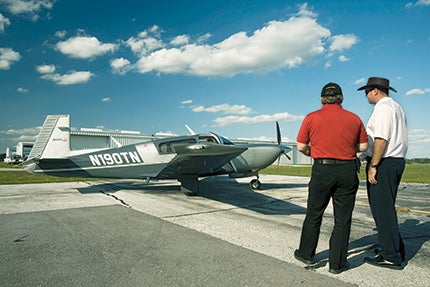

It's a safe bet that before the ink was dry on your solo endorsement, you started thinking about buying an airplane. If you stayed with the same FBO after your checkride, the negative aspects of renting became clear: dirty cockpits, long squawk lists, items held together with duct tape, and having to schedule weekend flights far in advance. Like many pilots, you probably made some calculations and figured out that you could never afford to own. Most people stop there. But there's a way that almost anybody with just about any income can own an airplane. The answer: a partnership or, more correctly, a co-ownership.
Why Co-Ownership?
Let's begin by getting rid of the word "partnership." In legal terms, a partnership refers to an association of two or more persons who, together, operate a business for profit. The key phrase there is "for profit." Since two people wanting to own an airplane has nothing to do with profit, "co-ownership" is the proper legal term. The simple reason for co-owning is to spread the costs of owning an aircraft among multiple owners. Two owners cut the costs in half. Three cuts the cost by 65%, and so on. Also, because fixed costs like hangar rental and annual inspections stay the same no matter how often you fly, co-ownership has the peculiar advantage that every hour you fly is cheaper than the one before.
What Kind Of Organization?
There are different ways to legally organize a co-ownership, and there are pros and cons to each. The type of organization carries various financial and liability implications, and specifies the legal operating parameters of the entity.
Simple co-ownership: There are two flavors of co-ownership: tenancy in common and joint tenancy. The main distinction between the two is the way a co-owner's interest (the person's share of the airplane) is dealt with when he or she dies. In a tenancy in common, the interest passes to heirs based on the co-owner's will. In a joint tenancy, the interest is passed to the other co-owners instead of the co-owner's heirs. A co-ownership isn't taxed because it isn't a business entity. This is the simplest multiple-owner arrangement.
LLC: Limited liability companies are attractive to owner groups because they limit the liability exposure of the individuals. If a mishap occurs, lawyers can't go after the personal assets of the individual members. In an LLC, members don't own the airplane. The airplane is owned by the LLC, and the individual members, in turn, own shares of the LLC. As far as taxes, members of an LLC report their share of profits/losses on their individual tax returns.
Incorporation: Forming a corporation is neither cheap nor easy, and might be overkill for a small group of co-owners. Still, the liability protection and tax implications are attractive to some. There are different types of corporations based on state laws, and each has varying fiduciary responsibilities. Incorporation is beyond the context of this article and should be researched with an attorney.
The Key To Co-Ownership: The People
Every pilot I spoke with cited choosing the right partners as the #1 key to successful co-ownership. "Ultimately, it's the people," says Lou Betti. "My partners are dedicated, professional and reasonable." Betti is the owner and founder of DreamFleet (www.dreamfleet2000.com), which creates add-ons for Microsoft Flight Simulator. He's one of eight owners of a Piper Dakota; because his experience with partners has been positive, Betti is now considering co-ownership of a Cessna 210.
Partners should be selected with care. They need to be individuals who are trustworthy and have a track record of integrity. You may need to run background and credit checks and call personal references. Too many co-owner arrangements have ended in dissolution because of simple things like how clean a partner is or how meticulous the person is about maintenance. Before entering into any co-ownership, ask yourself if you're flexible enough to give a little here and there and to accept that not everybody will operate the airplane the way you would.
The Elephant In The Room
Insurance is one of the critical aspects of co-ownership. It covers the cost of the airplane if it's damaged, destroyed or stolen. It protects your own assets if your airplane causes damage to someone's property. An improperly insured aircraft can wipe out the life savings of all co-owners and create a lifetime of problems. Remember that all co-owners are liable for the actions of one.
"Don't call your group a flying club," says Bob Mackey, senior vice president of Falcon Insurance Agency (www.falconinsurance.com). "Bells and whistles go off, and insurance companies picture a bunch of guys and a clipboard on an oak tree with an airplane key hanging from it and nobody in charge." He advises keeping co-ownership groups small. "From one to three pilots, there's zero surcharge in insurance premiums. That can go up 10% to 20% with the addition of a fourth pilot, and up from there."
In a co-owner group, insurance premiums will be based on the experience level of the pilot with the least flight time. Insurance companies give discounts if, for example, everyone in the group has an instrument rating. The thing to remember about insurance is that trying to save a few dollars by skimping on coverage is a recipe for disaster.
Operations & Written Agreements
Operating on a verbal or handshake agreement "among friends" is asking for trouble. Agreements can contain nearly 60 items that should be addressed, from arbitration to washing of the aircraft. The good news is that many successful groups operate with basic agreements.
Successful co-owners suggest certain starting points. The first is a joint checking account specifically for the airplane. All payables and receivables go through only that account. On a related note, it's important to assign specific duties like bookkeeping and maintenance. Even in a two-person co-ownership, one person must keep detailed financial records of all transactions and keep an accurate eye on the group's account. The maintenance person is the only one who can give approval for maintenance tasks or parts purchases.
Scheduling the aircraft is a main concern and should be a mechanism that's accessible 24/7. Most owner groups use online scheduling solutions that range from free to low-cost. Places like www.schedule-now.net will set up an online scheduling system for $5.95 per month. Fuel options should be spelled out. Owners can either pay for their own fuel out-of-pocket, or pay into the group's checking account based on their flight time, kept in a log. The flight log is an important tool and can be based on tach time because co-owners aren't operating for profit.
Other items that should be addressed include whether co-owners will do owner-assisted maintenance, because prepping an aircraft for annual inspections can save a lot of money. Finally, a contingency fund is recommended to take care of unforeseen maintenance issues. There are several agreement templates online (for example, try AOPA's free-for-members version at www.aopa.org/members/files/guides/multiple.html).
Two useful co-ownership references are Aircraft Partnership by Geza Szurovy and Buying and Owning Your Own Airplane by James E. Ellis. These books are excellent resources for both forming partnerships and for finding and buying the right airplane.
Paying For It
The main reason for co-ownership is to save money, but it might not be much. Based on how many hours you fly, you may find that you're only saving a little over renting. But as a co-owner, you'll enjoy a flexibility and peace of mind. The big benefit is that you'll be splitting the fixed costs, which include hangar rental, taxes, insurance and annual inspections, all paid monthly as a fixed amount. Your only ongoing expenses are the variable costs, such as fuel, oil, an engine-overhaul reserve fund and oil changes. If you join an existing group, you'll pay an amount to join that represents a percent share of the airplane. In a new co-ownership, each member is responsible for coming up with his or her share of the purchase amount.
Being an aircraft owner with a group of people you know and respect is one of aviation's true pleasures. Cost benefits aside, the joy of flying an airplane that you're intimately familiar with and that you have a personal stake in is a great pleasure.
| Fractional Ownership Luxury and convenience at a fraction of the cost |
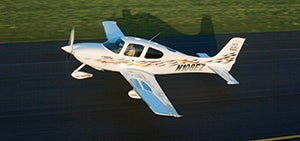 Fractional ownership is a term used to describe shared ownership of an expensive asset. When applied to aviation, fractional ownership usually involves a larger group of people than co-ownership and a more expensive aircraft, like a business jet or other high-performance airplane. The fractional owner purchases (or leases) a specific share amount of the airplane based on the number of hours the person flies in a year. There are additional cost components depending on the fractional ownership company. Most charge a monthly management fee that covers fixed, indirect operating costs like pilot training, hangars, etc. When occupying the aircraft, you usually pay an "occupied hourly fee" that covers direct costs like fuel, maintenance and catering. The fractional ownership company is responsible for hiring the pilots, maintaining the aircraft, handling all scheduling and logistics, and maintaining safety programs. The fractional owners get to enjoy the luxury, delay-free travel, convenience and safety of a private aircraft without any of the hassles, and at a fraction of the cost of sole ownership. Fractional ownership is a term used to describe shared ownership of an expensive asset. When applied to aviation, fractional ownership usually involves a larger group of people than co-ownership and a more expensive aircraft, like a business jet or other high-performance airplane. The fractional owner purchases (or leases) a specific share amount of the airplane based on the number of hours the person flies in a year. There are additional cost components depending on the fractional ownership company. Most charge a monthly management fee that covers fixed, indirect operating costs like pilot training, hangars, etc. When occupying the aircraft, you usually pay an "occupied hourly fee" that covers direct costs like fuel, maintenance and catering. The fractional ownership company is responsible for hiring the pilots, maintaining the aircraft, handling all scheduling and logistics, and maintaining safety programs. The fractional owners get to enjoy the luxury, delay-free travel, convenience and safety of a private aircraft without any of the hassles, and at a fraction of the cost of sole ownership. |
| Fractional Providers |
| Generally, fractional members buy partial interest in an aircraft that's operated by a company as part of its fleet. Fractional ownership initially became popular for jet planes, but it now includes smaller, single-engine aircraft. |
| Company | What It Offers |
| AirShares Elite www.airshareselite.com | Shared ownership in a Cirrus SR22. |
| Avantair www.avantair.com | Fractional shares in the Piaggio Avanti P.180. |
| CitationShares www.citationshares.com | Shared ownership of Cessna Citation Bravo, CJ3, XLS and Sovereign jets. |
| Flexjet www.flexjet.com | New fleet of Lear and Challenger jets. |
| LetsFly www.letsfly.org | A "cooperative" of LSA, Mooney, Liberty and Cirrus models. |
| NetJets www.netjets.com | A fleet of luxury jets from Cessna Citations to Gulfstreams and the BBJ. |
| OurPlane www.ourplane.com | Fractional ownership in the Cirrus SR22-GTS, Cessna 182T and Eclipse 500 VLJ |
| PlaneSmart www.planesmart.com | Equity ownership in a Cirrus SR22-G3 Turbo. |
| A Father/Son Co-Ownership An airplane becomes a family affair By Bill Cox |
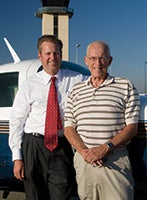 Father Don Stephens and son Bill have maintained a co-ownership on their 1981 Mooney 201 for more than 20 years in Orange County, Calif. "The Mooney is an ideal co-ownership airplane," says Bill, general manager of Cerritos Infiniti in Cerritos, Calif. "My dad and I rented a variety of airplanes for several years out of Fullerton Airport while we were considering buying our own. We considered the Grumman Tiger and the Piper Archer and Dakota, but the Mooney kept coming up way ahead in virtually every parameter---speed, climb, depreciation, economy, range, cabin room and everything else. It was also quite a bit more expensive, but with co-ownership, that was less of a problem." The two co-owners had basically the same philosophy regarding maintenance, an important consideration for any joint purchase. "Dad and I are in total agreement on that point," says Bill, "and that's something that should be established in every co-ownership. Nothing less than mechanical perfection should be acceptable. Some people tend to let things slide a little, but we insist that every system and every radio work all the time, or we won't fly the airplane." Don and Bill purchased the Mooney for $59,000 in 1986 with 1,100 hours on the engine, and Bill says he has insisted on participating in all the annual inspections, and has learned quite a bit in the process of helping the A&P through the various annual maintenance items. The father/son team has also repainted and reupholstered the airplane in the last few years, bringing it to near-new appearance and comfort. The two men fly the Mooney about 250 hours a year, but only Bill uses the airplane for business. "I'll sometimes fly to auto auctions around the southwestern U.S., California, Oregon, Arizona and Nevada, and the airplane usually allows me to save an overnight stay," he says. "I can fly to Oakland or Reno or some other location, spend the day there, buy a dozen or more cars and be back home the same evening." Father Don Stephens and son Bill have maintained a co-ownership on their 1981 Mooney 201 for more than 20 years in Orange County, Calif. "The Mooney is an ideal co-ownership airplane," says Bill, general manager of Cerritos Infiniti in Cerritos, Calif. "My dad and I rented a variety of airplanes for several years out of Fullerton Airport while we were considering buying our own. We considered the Grumman Tiger and the Piper Archer and Dakota, but the Mooney kept coming up way ahead in virtually every parameter---speed, climb, depreciation, economy, range, cabin room and everything else. It was also quite a bit more expensive, but with co-ownership, that was less of a problem." The two co-owners had basically the same philosophy regarding maintenance, an important consideration for any joint purchase. "Dad and I are in total agreement on that point," says Bill, "and that's something that should be established in every co-ownership. Nothing less than mechanical perfection should be acceptable. Some people tend to let things slide a little, but we insist that every system and every radio work all the time, or we won't fly the airplane." Don and Bill purchased the Mooney for $59,000 in 1986 with 1,100 hours on the engine, and Bill says he has insisted on participating in all the annual inspections, and has learned quite a bit in the process of helping the A&P through the various annual maintenance items. The father/son team has also repainted and reupholstered the airplane in the last few years, bringing it to near-new appearance and comfort. The two men fly the Mooney about 250 hours a year, but only Bill uses the airplane for business. "I'll sometimes fly to auto auctions around the southwestern U.S., California, Oregon, Arizona and Nevada, and the airplane usually allows me to save an overnight stay," he says. "I can fly to Oakland or Reno or some other location, spend the day there, buy a dozen or more cars and be back home the same evening." 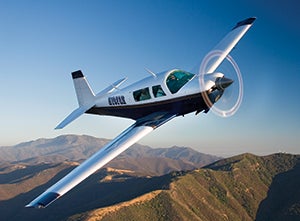 Bill feels that the most common conflict scenario of co-ownership rarely arises. There have been few instances when both owners wanted to use the airplane at the same time. "I'll bet there haven't been even a half-dozen instances in 20 years when we both wanted to use the airplane for different trips, and those have been easy to resolve," comments the younger Stephens. "For our purposes, the 201 is practically the perfect airplane," he continues. "It's relatively inexpensive to buy and own. Maintenance with the little 200 hp engine isn't too bad, and most systems are fairly simple. Performance is also more than adequate for our purposes. Our 201 is an early model with the shorter wings, so it offers a consistent 160 knots [184 mph] on 11 gph. Even at today's prices, that's fairly efficient, typically worth 17 smpg in automotive terms. It makes an excellent transport for two people plus all the baggage you can stuff aboard, the way most people fly four-place airplanes anyway. The standard 64-gallon tanks provide five hours of endurance. That's longer than most of us are willing to sit in any airplane." Bill says he and his dad have never bothered to figure the hourly cost of their shared Mooney 201, not because they'd just as soon not know, but because it's not that significant a number. "Keeping the airplane in the family obviously gives us some advantages over other co-ownerships, but we try to maintain a very businesslike attitude about all aspects of the Mooney's operation," he says. Don and Bill are so content with the economics of their current co-ownership, they have no plans to upgrade airplanes anytime soon. "The 201 is exactly the right airplane for us," says Bill. "It's more than fast enough for our missions, carries what we need to carry and, most important of all, it's within our respective budgets." [For more, see our web-exclusive story, "Mooney 201: The Airplane That Saved A Company," at the end of this article.] Bill feels that the most common conflict scenario of co-ownership rarely arises. There have been few instances when both owners wanted to use the airplane at the same time. "I'll bet there haven't been even a half-dozen instances in 20 years when we both wanted to use the airplane for different trips, and those have been easy to resolve," comments the younger Stephens. "For our purposes, the 201 is practically the perfect airplane," he continues. "It's relatively inexpensive to buy and own. Maintenance with the little 200 hp engine isn't too bad, and most systems are fairly simple. Performance is also more than adequate for our purposes. Our 201 is an early model with the shorter wings, so it offers a consistent 160 knots [184 mph] on 11 gph. Even at today's prices, that's fairly efficient, typically worth 17 smpg in automotive terms. It makes an excellent transport for two people plus all the baggage you can stuff aboard, the way most people fly four-place airplanes anyway. The standard 64-gallon tanks provide five hours of endurance. That's longer than most of us are willing to sit in any airplane." Bill says he and his dad have never bothered to figure the hourly cost of their shared Mooney 201, not because they'd just as soon not know, but because it's not that significant a number. "Keeping the airplane in the family obviously gives us some advantages over other co-ownerships, but we try to maintain a very businesslike attitude about all aspects of the Mooney's operation," he says. Don and Bill are so content with the economics of their current co-ownership, they have no plans to upgrade airplanes anytime soon. "The 201 is exactly the right airplane for us," says Bill. "It's more than fast enough for our missions, carries what we need to carry and, most important of all, it's within our respective budgets." [For more, see our web-exclusive story, "Mooney 201: The Airplane That Saved A Company," at the end of this article.] |
| That's My Warbird Fly History offers a new twist on shared ownership |
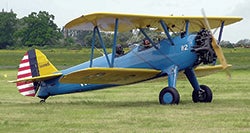 When it comes to daydreaming about airplane ownership, warbirds top most pilot's lists. For those who have experienced one of these beasts from the pilot's seat, nothing else comes close. Owning a warbird, however, is just one step below "finding lost Mayan treasure" on the possibility scale for most of us. A new company, Fly History LLC, is offering 20 charter-member slots in each of six locations across the country, giving flying club--type access to actual warbirds. Each location will house one T-6 Texan, one Stearman PT-17 and two T-34 Mentors. Member pilots will have full access to all of these aircraft, just like any standard flying club. When it comes to daydreaming about airplane ownership, warbirds top most pilot's lists. For those who have experienced one of these beasts from the pilot's seat, nothing else comes close. Owning a warbird, however, is just one step below "finding lost Mayan treasure" on the possibility scale for most of us. A new company, Fly History LLC, is offering 20 charter-member slots in each of six locations across the country, giving flying club--type access to actual warbirds. Each location will house one T-6 Texan, one Stearman PT-17 and two T-34 Mentors. Member pilots will have full access to all of these aircraft, just like any standard flying club. 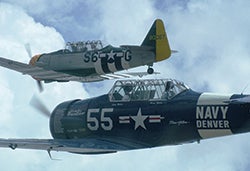 There are strict experience requirements. To fly the T-6 solo, for example, you must be a private pilot with a tailwheel endorsement, 1,000 hours of total time, 250 hours in a retract and at least 100 hours in a tailwheel airplane. Fly History maintains a full training program that parallels the military and includes instructors with considerable warbird experience. This training allows member pilots to act as PIC in any of these formidable aircraft. Exact figures vary by location, but a member slot costs about $1,380 per month, plus an hourly rate on each airplane (except the T-6) of $165 an hour, dry. The T-6 will rent for about $275 per hour, dry. What you get for all that is the cachet of pulling up to your next hamburger run in a snarling war-era airplane. "Aviation is just a bunch of people who are passionate about airplanes and are looking for more," notes Fly History founder Jeff Simon, "and nothing beats flying one of these airplanes." For more, visit www.flyhistory.com. There are strict experience requirements. To fly the T-6 solo, for example, you must be a private pilot with a tailwheel endorsement, 1,000 hours of total time, 250 hours in a retract and at least 100 hours in a tailwheel airplane. Fly History maintains a full training program that parallels the military and includes instructors with considerable warbird experience. This training allows member pilots to act as PIC in any of these formidable aircraft. Exact figures vary by location, but a member slot costs about $1,380 per month, plus an hourly rate on each airplane (except the T-6) of $165 an hour, dry. The T-6 will rent for about $275 per hour, dry. What you get for all that is the cachet of pulling up to your next hamburger run in a snarling war-era airplane. "Aviation is just a bunch of people who are passionate about airplanes and are looking for more," notes Fly History founder Jeff Simon, "and nothing beats flying one of these airplanes." For more, visit www.flyhistory.com. |
| Mooney 201: The Airplane That Saved A Company By Bill Cox |
| WEB EXCLUSIVE ! |
| It was 1974, and Mooney was in trouble. A successful builder of four-seat retractables since the '50s, the Kerrville, Texas, company was having a hard time competing against a quartet of comparatively new retractables, all powered by essentially the same four-cylinder, 200 hp Lycoming engine, the IO-360. Piper's popular Arrow, with its innovative automatic gear-extension system, was selling well, stealing sales directly from Mooney. Cessna was building the slick, strutless, retractable version of the Cardinal, another airplane that cut into Mooney's market. Rockwell Commander was offering the big-cabin, upscale, model 112, and Beechcraft was marketing its Sierra, a 200 hp, gear-up variation on the successful Sundowner. Against so much competition, Mooney needed to pull a rabbit out of the hat if it hoped to survive. To that end, Mooney owner Republic Steel brought in aerodynamicist and speed guru Roy LoPresti from Grumman American. LoPresti was the father of the Cheetah and Tiger, and his mission at Mooney was to increase the airplane's performance without increasing production costs. The Mooney Chaparral and Executive were already the fastest machines in the class, but Republic felt it needed a truly dramatic performance increase to pull away from the competition. Additionally, any changes to the product line would need to be accomplished with no gross weight increase. Accordingly, LoPresti set to work modifying the Executive, Mooney's flagship model at the time. "Frankly, I thought the better vehicle for the changes would be the faster, short-fuselage Chaparral," LoPresti told me several years ago. "The Chaparral had more speed to begin with, but the company was adamant that the stretched Executive fuselage was the preferred target for the mods. I didn't agree, but as I look back on it now, they were definitely right." In the short span of two years, LoPresti, Rocky Peters and a small group of dedicated Mooney engineers slicked and faired the Executive with some 30 speed mods. They redesigned the windshield to a more swept-back profile and reconfigured the cowling strictly for speed rather than as a compromise between speed and climb. To handle the extra heating associated with climb, they mounted extra large cowl flaps. The gear doors were redesigned to cover more of the wheels, further reducing drag beneath the wing. Flush riveting was extended to cover the forward 60% of wing chord and all wing hinges were enclosed with fiberglass fairings. LoPresti also expanded use of gap seals to the flaps, a feature previously employed on ailerons and elevator. A new, slicker fairing was mounted for the forward vertical stabilizer intersection with the fuselage, the OAT was modified to a tiny probe beneath the airplane, the tail tiedown was reduced in size and a myriad of other small changes further improved what was already the fastest airplane in the class. The result of these innovations was 18 mph more top speed, boosting that number to 201 mph, and raising max cruise to more like 195 mph (169 knots). The M20J was born, and its performance outpaced that of the four other retracts in practically every area. The results of the 201's preeminence were predictable. The new Mooney created a sensation. The company dropped the short-body Ranger and Chaparral but sold nearly a thousand of the new M20Js in 1977, 1978 and 1979. The Mooney 201 was to survive for 20 years before the company adopted more horsepower and the entry-level model became the long-body Mooney M20S Eagle. |